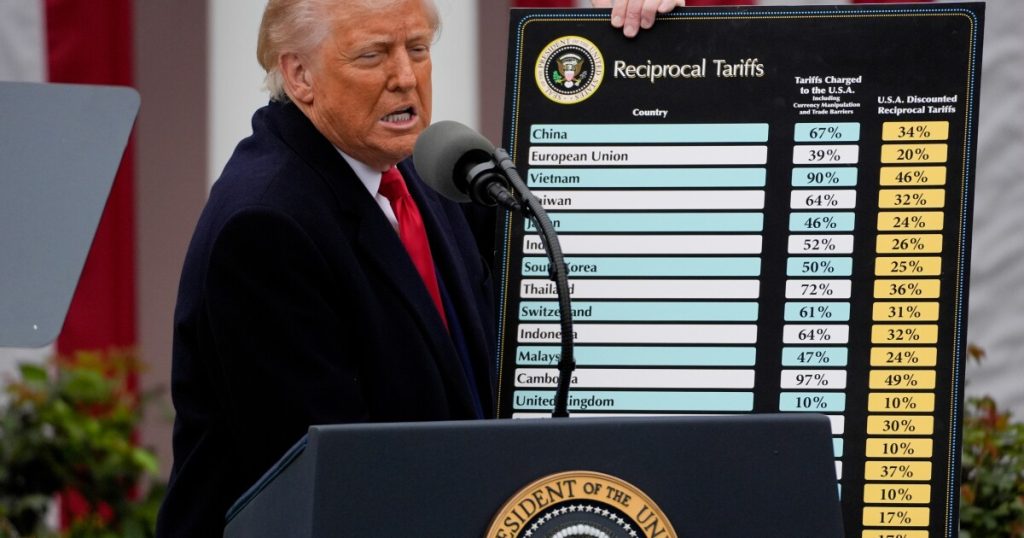Even before President Trump unveiled his sweeping new tariffs, many Americans were struggling to afford car purchases, putting their loans in growing danger of default.
Now hefty tariffs threaten to inflict further pain on U.S. car buyers, which could have negative consequences for auto lenders.
“There are nearly unlimited permutations of the knock-on effects,” UBS analyst Joseph Spak wrote in a research note. “The cost to make vehicles is going higher. Eventually, the price of vehicles will go higher.”
As car prices rise, borrowers may have a harder time staying current on their loans.
Indeed, many car buyers are already stretching to afford their purchases. In the first quarter of 2025, 84-month loans hit an all-time high at 19.8% of new-vehicle financing, according to the data provider Edmunds.
Auto loans with seven-year terms reduce the borrowers’ monthly payments in comparison with more traditional, shorter-term loans. But they also add to lenders’ risk, since the amount of money that lenders can recover on a repossessed car diminishes as the vehicle ages.
“When one in five new-car buyers are taking on seven-year loans, it’s clear how many consumers are still financially stretched,” Jessica Caldwell, Edmunds’ head of insights, said in a
Trump’s 25% levy on all foreign-built cars took effect on Thursday. Separately, the president has announced across-the-board tariffs on imported goods from almost all U.S. trading partners, ranging from 10% to 49%.
The tariffs on imported cars are separate from — not in addition to — the tariffs Trump announced on Wednesday. For instance, the European Union is now subject to a 20% tariff, but that levy will not stack on top of the 25% tariff on European cars, Spak noted.
However, Spak wrote, the latest round of tariffs do target countries that manufacture important materials for car production, such as nickel and electronic components. The higher costs of those materials will drive up car prices, he said.
Trump has vowed that the new policy will bring manufacturing jobs back to the U.S. Some automakers, including General Motors, have mused about relocating factories onto American soil. But it remains to be seen whether their words will translate into action, how quickly that will happen, and how much additional domestic production might offset the effects of tariffs.
A rising number of U.S. car owners have been falling behind on their loan payments in recent months. In February 2025, delinquencies were up and balances were rising, according to the credit modeling company
“Certainly, households are struggling to make payments,” said Atif Mirza, one of the lead analysts on VantageScore’s report.
February marked the second straight month that delinquencies rose in every category of days past due. On a month-to-month basis, 90-to-199-day delinquencies rose particularly steeply, from 0.2% to 0.45%.
“Borrowers are making tough choices to prioritize their debt obligations and auto loans are decreasing in priority,” Susan Fahy, VantageScore’s chief digital officer, said in a statement.
Given the surge in car prices since the start of the pandemic, it’s perhaps not surprising that more consumers are falling behind on their auto loans. Since February 2020, new and used vehicle prices have risen by an average of 26%, according to the
“In the past year and a half, we saw a rise in interest rates and … prices for a new car and used car have gone up significantly,” Mirza said. “The average monthly payment on a car loan has also increased significantly, and that has an extra impact on the burden for the average household.”
In this year’s first quarter, the average interest rate on a new vehicle loan was 7.1%, according to
“The auto finance market showed signs of steadiness in Q1, but that stability doesn’t mean affordability has improved,” Caldwell said.
It’s unclear whether the tariffs announced this week will persist in their current form. In the past, Trump has withdrawn or scaled back other tariffs he imposed, though he said Wednesday that the new ones are “100%” permanent. If that’s true, it could make car loans even less affordable than they already are for many Americans.
“With auto tariffs officially taking effect today, there’s a risk that they will add fuel to the fire,” Caldwell said, “triggering a disruption that could push vehicles even further out of reach for many shoppers.”

